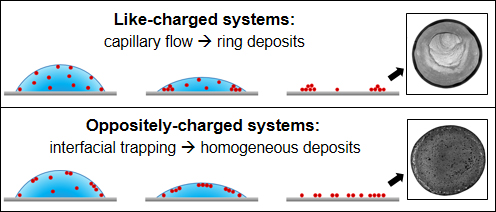Abstract:
We study the effect of surfactants on the deposits formed after the evaporation of colloidal suspension drops, at initial concentrations lower than the critical micellar concentrations, for various particle/surfactant mixtures. We show that the surfactant-mediated interactions between particles and the liquid-gas (LG) and liquid-solid (LS) interfaces, rather than the flow patterns, primarily define the morphology of the dry deposit in a robust and reproducible manner. For like-charged particle/surfactant mixtures, most of the particles form a ring-shaped deposit (according to the so called “coffee-ring effect”) but some particles can also be deposited inside the ring in a way that is modulated by electrostatic interactions between the particles and the LS interface. For oppositely charged systems, surfactant adsorption to the particle surface strongly affects particle-LG interface interactions, which in turn control the deposition pattern. For low surfactant concentrations, coffee-rings are systematically observed. For intermediate concentrations, the charge of surfactant-decorated particles becomes nearly neutral and their hydrophobicity is enhanced, which promotes particle trapping at the LG interface. A particle skin is formed and its deposition upon drying leads to homogenous disk-like patterns. For high surfactant concentrations, particle charge is reversed and coffee-rings are observed again. Notably, this ring-disk-ring evolution of the deposition behaviour as a function of surfactant concentration is observed in a variety of mixtures, regardless of particle absolute charge and surface chemistry as well as of surfactant charge and hydrophobicity. Its apparent universal character makes it a promising strategy for a robust control of particle deposition from evaporating drops.
Reference:
We study the effect of surfactants on the deposits formed after the evaporation of colloidal suspension drops, at initial concentrations lower than the critical micellar concentrations, for various particle/surfactant mixtures. We show that the surfactant-mediated interactions between particles and the liquid-gas (LG) and liquid-solid (LS) interfaces, rather than the flow patterns, primarily define the morphology of the dry deposit in a robust and reproducible manner. For like-charged particle/surfactant mixtures, most of the particles form a ring-shaped deposit (according to the so called “coffee-ring effect”) but some particles can also be deposited inside the ring in a way that is modulated by electrostatic interactions between the particles and the LS interface. For oppositely charged systems, surfactant adsorption to the particle surface strongly affects particle-LG interface interactions, which in turn control the deposition pattern. For low surfactant concentrations, coffee-rings are systematically observed. For intermediate concentrations, the charge of surfactant-decorated particles becomes nearly neutral and their hydrophobicity is enhanced, which promotes particle trapping at the LG interface. A particle skin is formed and its deposition upon drying leads to homogenous disk-like patterns. For high surfactant concentrations, particle charge is reversed and coffee-rings are observed again. Notably, this ring-disk-ring evolution of the deposition behaviour as a function of surfactant concentration is observed in a variety of mixtures, regardless of particle absolute charge and surface chemistry as well as of surfactant charge and hydrophobicity. Its apparent universal character makes it a promising strategy for a robust control of particle deposition from evaporating drops.
Reference:
Modulation of the coffee-ring effect in particle/surfactant mixtures: the importance of particle-interface interactions
M. Anyfantakis,* Z. Geng, M. Morel, S. Rudiuk, D. Baigl*
Langmuir 2015, 31, 4113 – 4120
![]() - doi : 10.1021/acs.langmuir.5b00453
- doi : 10.1021/acs.langmuir.5b00453
